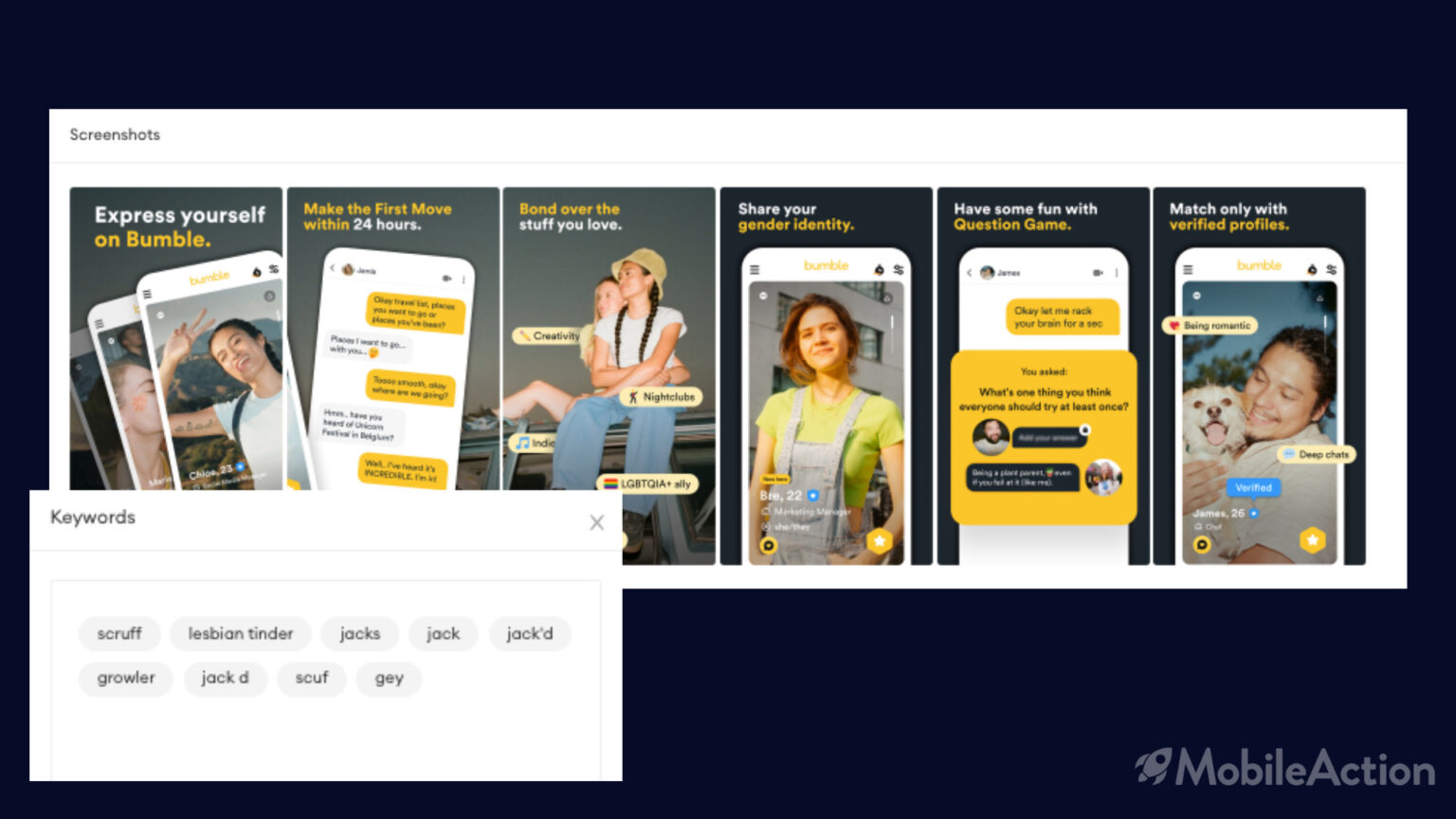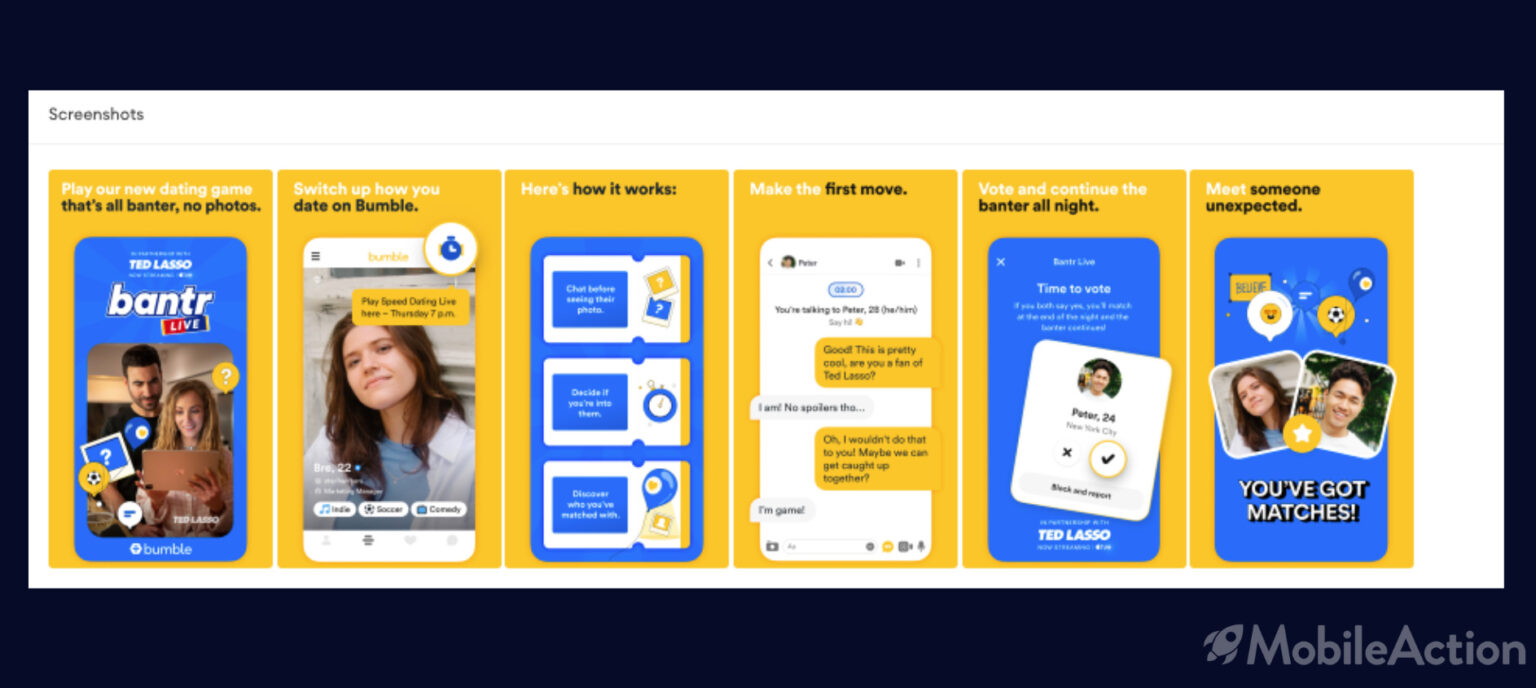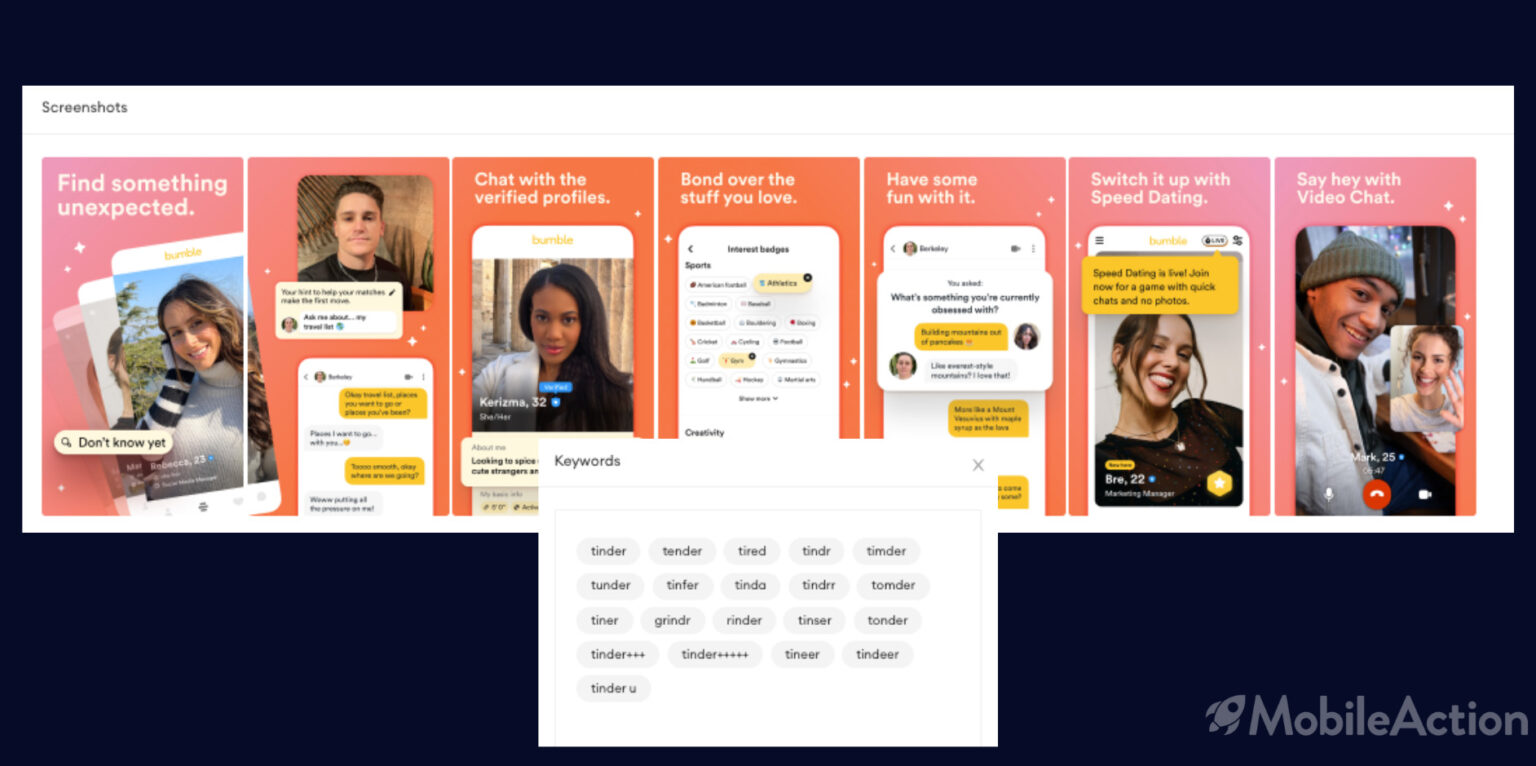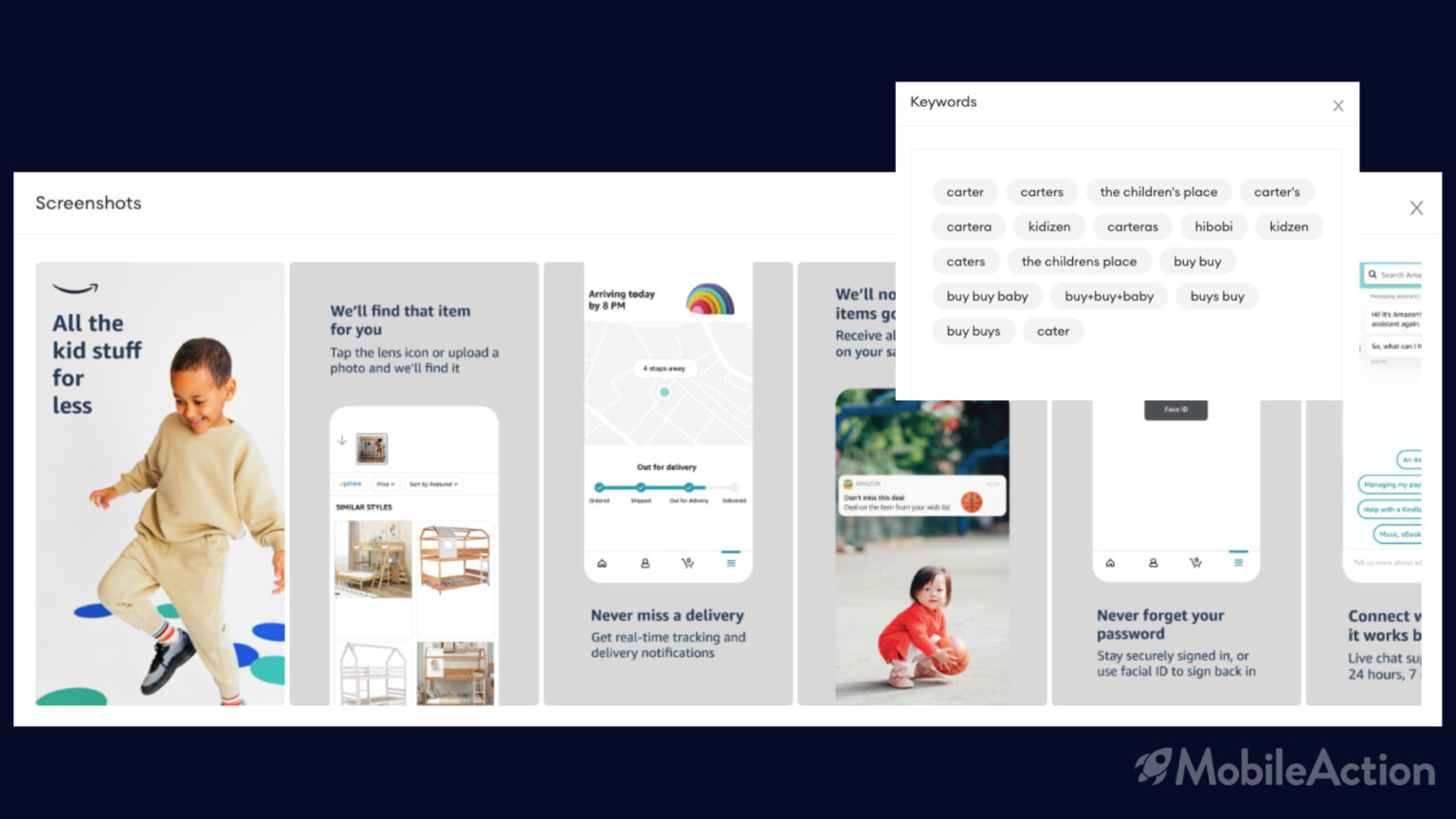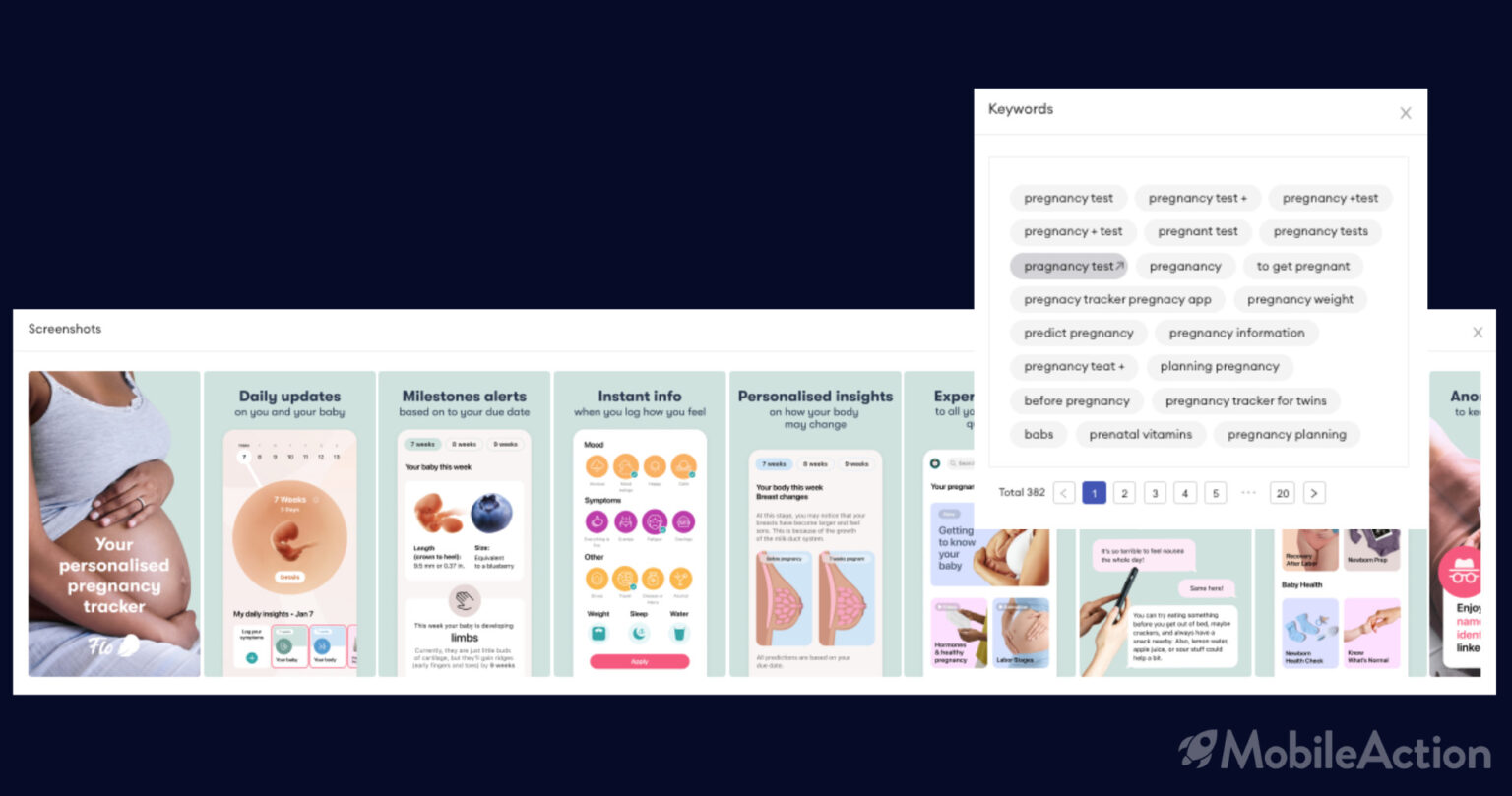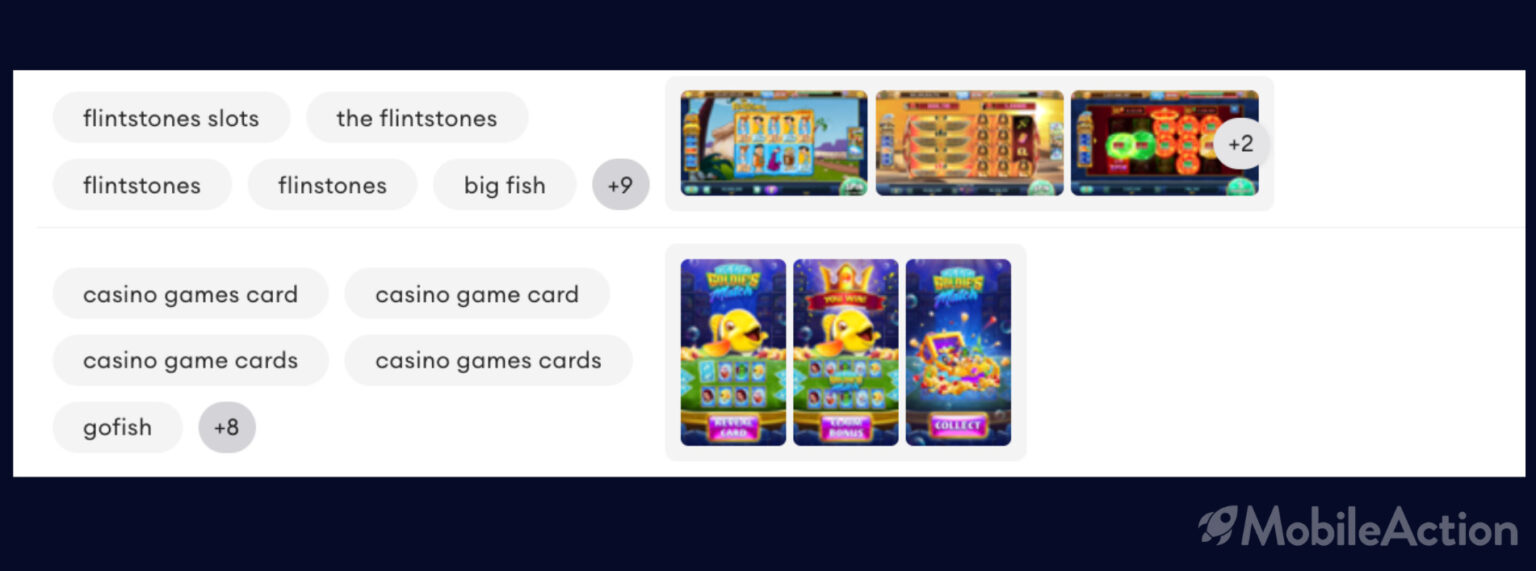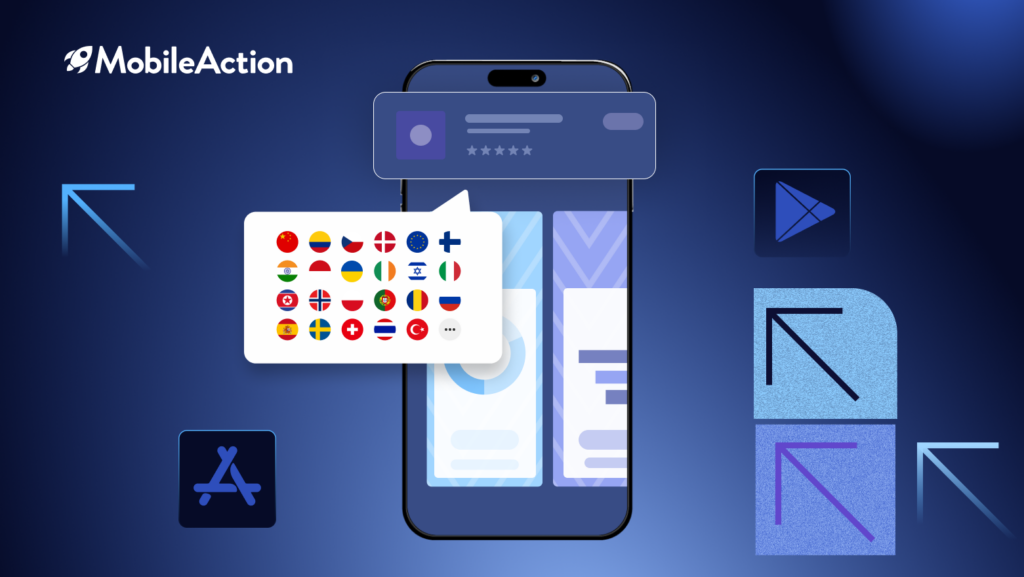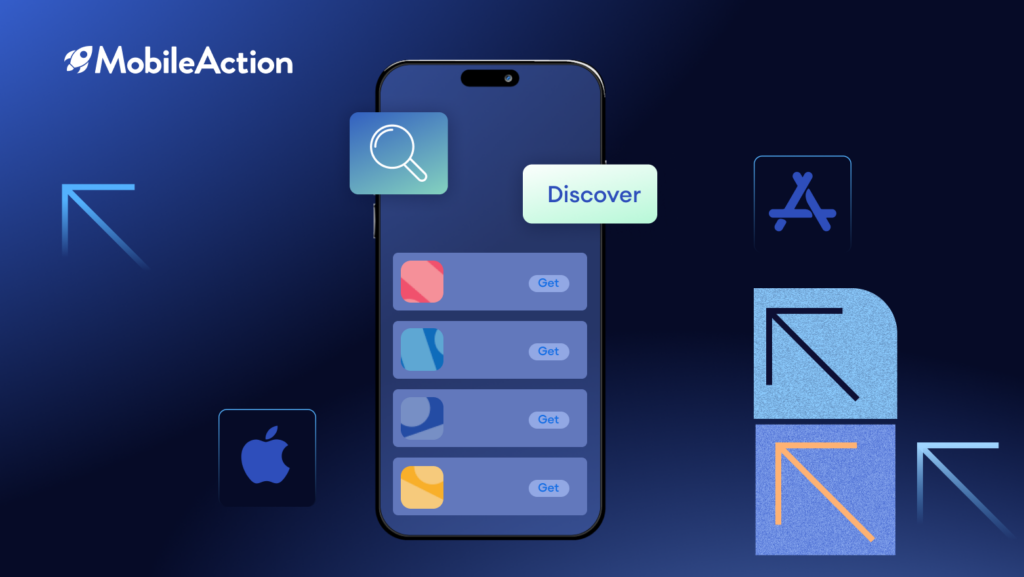Key Takeaways:
- Up to 35 custom product pages per app allow for targeting multiple audience segments simultaneously with content that resonates with their specific interests and needs. It gives you the opportunity to customize for each audience group.
- Effective use of custom product pages involves a deep understanding of your app’s unique value proposition, your target audience, and the competitive landscape.
- Leveraging tools like MobileAction’s CPP Intelligence and Compass Explore/Trace/Impact for competitor and keyword analysis is crucial for informed decision-making and continuous improvement of your custom product pages.
- The creative set, including visuals and copy, should be compelling and directly speak to your target audience’s preferences and pain points.
- Regular A/B testing and analysis of performance metrics are essential for identifying the most effective elements of your custom product pages and refining them for optimal performance.
- Following Apple’s advertising policies and guidelines ensures that your custom product pages attract users and maintain the integrity and safety of the App Store environment. Also, keep in mind that if your custom product pages do not pass the review process, your custom product pages cannot be published.
- Marketing your custom product pages through various channels, including social media, email, print, and influencer partnerships, is key for driving traffic and conversions.
- Monitoring key performance indicators (KPIs) like conversion rate (CR), click-through rate (CTR), and retention rate provides insights into the effectiveness of your custom product pages and informs future strategies.
- Custom product pages significantly enhance App Store Optimization (ASO) and paid User Acquisition (UA) efforts, leading to a cohesive app marketing strategy.
- The app market and user preferences are changing every day. Staying informed about trends, updating your custom product pages accordingly, and engaging with a community of app marketers will keep your strategies fresh and compelling.
If you are considering leveraging custom product pages for the first time or seeking ways to enhance your performance and analyze it more effectively, this is the guide you need.
Within this comprehensive guide, you’ll discover everything related to custom product pages, from their creation and marketing strategies to potential use cases and benefits.
Learn when, where, and how to leverage custom product pages and how to achieve optimal results. Explore expert tips and techniques for optimizing their performance, including valuable insights and best practices.
Basically, it’s everything you need to know about custom product pages.
What are custom product pages?
Over 650 million people go to the App Store weekly to discover and download apps. Around 70% of App Store visitors use “search” to discover apps and almost 65% of the downloads happen directly after a search.
Your app’s product page serves as the initial point for you to impress your potential users.
It is the primary area where you connect with your audience, conveying your values and emphasizing why user experience should be the focal point.
The creative elements on your product page play an important role as users often decide whether to download your app based on this creative set.
Consequently, these pages serve as the initial point of contact, making them essential in shaping the user’s perception. It is also important to highlight that 71% of consumers expect personalized offers or communication efforts.
With the introduction of iOS 15, custom product pages have been added to the mobile app world. This feature, integrated into Apple Ads Advanced search results ad groups, enables the creation of ad variations tailored to specific keyword themes and target audiences.
The advantage of custom product pages lies in their ability to provide more relevant and engaging App Store experiences for different customer segments.
Why should custom product pages be considered?
Custom product pages prove instrumental in displaying specialized content to distinct audiences and refining targeting strategies. You can create up to 35 distinct custom product pages for each app, this presents you with the ability to target 35 different audience groups.
As users encounter content tailored to their search queries, the likelihood of downloads and conversions is significantly heightened.
In short, custom product pages ensure that the appropriate users view the relevant product pages, making the conversion process smoother.
The ability to tailor pages to specific keywords and audiences increases the likelihood of appearing in relevant search results, ultimately attracting users to your app.
Who should use custom product pages?
Apple Ads Advanced users can utilize custom product pages. Experts suggest that custom product pages can be beneficial for every type of user who has the budget for this feature.
Especially if your app has more than one feature, like if your app has both healthy meal recipes and fitness advice at the same time, it is suggested that you showcase your features with custom product pages so you can target different audiences with different keywords.
The audiences interested in utilizing them may also vary. Utilizing custom product pages enables you to promote specific aspects of your app to audiences seeking both diet and sports features simultaneously.
Even if your product page includes information about both features, providing detailed information about each feature individually will capture the attention of users looking for specific functionalities.
How to make a new ad variation based on custom product page?
It is much easier than you think to create ad variations using custom product pages.
Preparing your new strategy requires 6 easy steps. However, the real challenge is not just about creating your custom product pages; it’s about formulating your strategy with a data-driven plan.
It is important to set your goals first, decide on your target audience, and build the creative set that you want to show to that specific audience for better conversion.
Don’t be scared; we cover all of this in this guide.
Let’s start with the creation part, and we’ll delve into the strategizing part more closely.
Here are the 6 steps to make a new ad variation:
- From the Ad Groups dashboard, click an ad group to access the Ads dashboard.
- Click the Create Ad button on the Ads dashboard.
- Name your new custom ad.
- Select the custom product page you want to determine your ad creative. This product page will also be where users go when they tap your ad.
- Preview your custom ad. Note that if you’re testing different app icons in App Store Connect, the icon in your preview may differ.
- Click Save.
How do you strategize with custom product pages?
To strategize with custom product pages, start by understanding your app’s unique value proposition and how it meets the needs of your target audience.
Analyze market trends, competitor strategies, and user behavior to inform the design and messaging of your pages.
Consider creating multiple custom product pages tailored to different user segments or marketing campaigns to test which resonates best with your audience.
Use data-driven insights from platforms like MobileAction to refine and optimize your pages over time.
How do you decide your target audience?
Identifying your target audience involves understanding who your app is for and why they would find it valuable.
- Conduct market research to gather demographic and psychographic information about potential users, including age, gender, interests, and pain points.
- Analyze data from your existing user base, if available, and consider using surveys or focus groups to gather more insights.
- Segment your audience based on these findings to create more personalized custom product pages.
How do you set your goal before you start?
Setting clear, measurable goals is crucial before starting with custom product pages. Determine what you aim to achieve, such as increasing app downloads, boosting engagement, or improving conversion rates.
Your goals should be SMART: Specific, Measurable, Achievable, Relevant, and Time-bound.
For instance, you might aim to increase app downloads by 20% within three months by targeting specific user segments with tailored custom product pages.
How to create your assets?
Creating assets for your custom product pages involves designing visually appealing and relevant images, videos, and copy that align with your brand and appeal to your target audience.
Use high-quality screenshots and videos that showcase your app’s features and benefits.
Write a compelling clear copy about what your app offers, including headlines, subheadings, and calls to action. Ensure your assets are optimized for different devices and screen sizes to provide a consistent user experience.
Try to highlight specific features for the specific audience you want to target.
For example, if you are targeting a women-specific audience, try to use in-app screenshots that are designed for women, or if you are targeting a kids’ audience, try to use figures or trends, maybe even cartoon characters, that can attract kids’ attention.
For copywriting, try to craft concise, compelling copy that speaks directly to your target audience’s needs and desires. Your headlines, app descriptions, and calls to action (CTAs) should clearly formulate the value your app provides.
Try to focus on the targeted audience’s needs, and try to use the words that will grab the attention of that specific target audience.
How do you select your keywords?
Keyword selection is a critical component of ASO and should be informed by thorough research.
Use platforms like MobileAction to identify high-traffic, relevant keywords that your target audience is using to find apps like yours.
Consider the balance between keyword popularity and competitiveness; sometimes, less competitive keywords can provide more targeted visibility.
Regularly review and update your keyword strategy based on performance data and market trends.
Best practices
- Consistency: Ensure your custom product page aligns with your brand’s visual identity and messaging. Consistency builds trust and recognition among your target audience.
- Relevance: Tailor your page to reflect the interests and preferences of your target demographic. Use language and imagery that resonates with them to increase engagement and conversions.
Common mistakes to avoid
- Information overload: Avoid cluttering your custom product page with too much text or too many images. Keep your message clear and focused.
- Neglecting updates: Regularly update your custom product pages to reflect new features, updates, or seasonal promotions to keep your content fresh and relevant.
- Ignoring A/B testing: Don’t settle for a single version of your custom product page. Use A/B testing to experiment with different elements and find what works best for your target audience.
Custom product pages and Today tab ads
Ads on the Today tab showcase your app’s icon, name, subtitle and direct users to a custom product page upon clicking.
The ad’s background dynamically features elements from the chosen custom product page, reflecting the color of your app’s icon.
To initiate a Today tab ad, it’s essential to first prepare a custom product page within App Store Connect.
Creating your campaign triggers an automatic submission for review. The review process by Apple Ads encompasses an evaluation of your app’s icon, name, subtitle, and custom product page elements to ensure compliance with Today tab ad regulations.
Once your materials have been reviewed for a specific Today tab campaign, further approvals are not necessary for subsequent campaigns in the same region, provided no changes are made to them in App Store Connect.
Following approval, your Today tab ad will go live immediately unless you’ve designated a specific launch date or opted to pause the campaign.
For your creatives to be approved by Apple, you need to follow a set of rules provided by Apple. These rules are to protect the safe environment of the App Store and its users.
Going by the guidelines will make your process much easier and faster.
Here are the guidelines you need to follow for approval.
Guidelines for the Today Tab Ads
- Content in your app’s icon, name, subtitle, and assets for custom product pages should not contain violent, offensive, explicit sexual manner, or otherwise unsuitable elements. Any imagery of firearms, weaponry, or violence is strictly prohibited.
- Your custom product page should adopt the primary language of the country or region where your advertising campaign is active.
- The app’s name and subtitle should align with the local language of the specific country or region targeted by your campaign.
- It is prohibited to feature any pricing information, special offers, rankings, or promotions aimed at incentivizing the app’s icon, name, subtitle, or assets for custom product pages. Furthermore, statements regarding the app’s rankings or accolades are not permitted.
- Usage of the terms “Game of the Day” and “App of the Day” in your app’s icon, name, subtitle, or custom product page assets is forbidden.
- Compliance with Apple’s Advertising Policies is mandatory for your app’s name, icon, subtitle, and custom product page assets.
Custom product pages creative testing
There is always room to grow, and for custom product pages, this means creative testing.
Without testing, you’ll never discover the best-case scenario for your app.
By conducting systematic testing of your custom product pages, you can identify the most effective ad creatives, messaging, keyword selection, headlines, or call-to-action strategies.
This process enables you to determine what resonates most with your target audience and optimize your overall app marketing efforts.
The testing process leads to improved user acquisition, higher conversion rates, and a more adapted user experience.
This strategic approach to testing and optimization is undeniable for maintaining competitiveness.
Imagine creating two identical custom product pages but using similar keywords as your default product pages for one and completely different keywords that align with your custom product pages’ theme for the other.
The insights gained from which one performs better are crucial, as they can shape your future strategies. In short, it’s essential to discover the best practices for your app.
Here are the testing steps that our experts suggest:
-
Establish testing goals
Begin by clearly defining what you hope to achieve with your testing.
For instance, you might want to identify which ad creatives resonate most with certain keyword themes or evaluate the effectiveness of various messaging approaches.
-
Generate varied ad sets
Craft several versions of custom product pages, each featuring unique ad designs, messages, and keyword choices.
Explore strategies such as targeting keywords related to competitor brands, highlighting new app features, or catering to particular user demographics.
-
Set up performance tracking
Keep tabs on the performance metrics for each custom product page variant.
Essential metrics to watch include the number of impressions, click-through rates, app downloads, conversion rates, and user engagement within the app.
-
Evaluate the data
Gather and examine the data collected during the testing.
Compare how different custom product page variations perform relative to each other and to the standard page. Seek out patterns, trends, and opportunities for enhancement.
-
Iterate and enhance
Leverage the insights obtained from your analysis to make iterative improvements to your custom product pages.
Adjust or overhaul pages that aren’t performing well, and reinforce the strategies that are proving successful.
-
Pursue ongoing optimization
Remember, testing and optimization are continuous endeavors.
As user preferences shift and market dynamics change, persistently update and refine your custom product pages to maximize their conversion potential.
Key benefits of custom product pages
-
Expanded audience reach
You’re allowed up to 35 custom product pages per app on the App Store.
This means you can target 35 distinct audiences concurrently, each with different targeting goals.
Alternatively, you can experiment with numerous custom product pages simultaneously to identify the most effective one for your objectives.
-
Targeted keyword integration
Custom product pages enable you to assign distinct keywords to each page, linking them to specific user groups or features with targeted messaging.
This approach enhances conversions with contextual relevance.
For example, consider a Health & Fitness app with various meal plans. While some users reach the original product page, others may reach a “keto diet” specific custom product page.
This segmentation can significantly boost conversion and download rates.
-
Enhanced marketing flexibility
Each custom product page comes with its own URL.
This enables you to utilize unique URLs for diverse marketing efforts, such as social media ads or promotional communications. (Except as a search results ad that you created with Apple Ads)
-
Performance assessment
A valuable aspect is the ability to compare the performance of your custom product pages against your default product page.
This analysis helps you determine whether users who download your app from a custom product page exhibit longer engagement or make higher in-app purchases.
-
Drive relevancy
Apple Ads presents multiple places for utilizing custom product pages. You can craft search results and variations based on your custom pages, tailoring messaging and visuals for various audiences, feature launches, or seasonal promotions.
Alternatively, you can direct users to a specific custom product page when they tap on your ad within the Today tab.
This streamlined experience boosts conversion rates and ensures potential customers reach the most relevant page, increasing the likelihood of successful interaction with your app or product.
-
Multi-placement strategy
Utilizing multiple app placements in Apple Ads enhances app visibility and scalability.
It broadens your reach, capturing a diverse user base and improving cost-efficiency.
This strategic approach often results in reduced CPAs and increased brand recognition, impacting various ad networks. Custom product pages enhance ad relevance, and combining search result ads with the Today tab boosts brand visibility.
The Today tab is the default in the App Store, providing high visibility.
Running Today tab ads increases familiarity and positively influences downloads. Adding product page ads offers further benefits, allowing you to appear on competitors’ product pages, enhancing user perception and driving downloads.
Why should you consider using custom product pages
- Feature highlighting: Showcase specific features or content within your app that cater to distinct user groups.
- Targeted campaigns: Craft tailored pages for different marketing campaigns or promotions to optimize user engagement.
- Seasonal offerings: Create pages that align with seasonal trends, holidays, or cultural events to maximize relevance.
- Market segmentation: Develop custom product pages targeting different audience segments, languages, or regions.
- Competitor targeting: Direct users searching for competitor apps to dedicated pages highlighting your app’s advantages.
Use cases of custom product pages from different categories
This section will examine some use cases from different apps of different categories.
Specific audience targeting
In this example, we see Bumble, a dating app, and they are targeting a section of the LQBTQ+ user base.
Bumble’s product page initially does not show unique features for this specific user group.
But here, Bumble used custom product pages to directly target these specific users. The chosen keywords also show their target, highlighting phrases like “lesbian dating,” “gay,” and “Jack’s,” which is an app designed exclusively for the LGBTQ+ community.
New feature promo
Once again, here Bumble is using custom product pages to show their new feature to their audience.
They created a distinct product page for the promotion of their new feature.
Competitor audience targeting
Here we have two examples; one of them is from Bumble again, targeting Tinder users, which is their close competitor.
They used Tinder’s brand keywords to target the users who search for Tinder’s brand keywords directly.
Another detail is the choice of color; they used red, the brand color of Tinder, instead of their brand color yellow.
The other example we have is Amazon, a comprehensive shopping app not exclusively tailored to kids, which has crafted custom product pages specifically aimed at the children’s segment.
An examination of their keywords reveals a clear targeting of Carter’s users, which is a store specializing in children’s merchandise.
Side feature promotion
Flo is a period tracking app, but they also present a pregnancy tracking feature.
Since they are mainly known for period tracking, users searching for “period tracking” will not come across pregnancy tracking features on the product pages.
Custom product pages emerge as the optimal strategy to boost this feature’s visibility.
Thus, when users look up terms associated with pregnancy tracking, they’re guided to a dedicated page rather than the standard Flo product page, which is primarily centered on period tracking functionalities.
Specialization in category
For this instance, we’re looking at an app within the Games category, more specifically, a casino-themed app.
Gold Fish Slots has adopted a custom product page to better serve its genre, given the absence of a specific “casino” category.
This approach enables a more accurate depiction of their game.
Moreover, vertical layouts are favored over horizontal ones, setting them apart from the norm in other categories.
Strategies for promoting tailored product pages
Once you have created your custom product pages, it’s time to market them to drive traffic and increase conversions.
Here are some powerful ways to market your custom product pages:
Social media marketing
Promoting custom product pages via social media is highly effective.
You can share the URL of your custom product page on platforms like Facebook, Instagram, Twitter, and LinkedIn.
Posting a story or image that includes the URL can also draw users to visit your custom product pages.
Email marketing
You can add your custom product page’s link or QR code in email marketing campaigns to reach your audience.
Consider adding the link to your weekly newsletters or promoting any forthcoming events or features.
Print marketing
Print marketing is a valuable tool for promoting custom product pages.
Generate a QR code for your page and include it in handouts, billboards, and flyers; you can easily connect offline customers to your online content.
In-store displays
For those with physical stores, in-store displays can highlight custom product pages.
Develop a page for a specific sale or promotion, create a QR code for the URL, and place it prominently in your store window to attract foot traffic and online visitors alike.
Influencer marketing
Leveraging influencer marketing can significantly boost visibility for your custom product pages, especially for a target audience.
Since they have existing followers interested in a similar topic, influencers can reach related people.
Collaborate with influencers to promote a page focused on a particular app feature, encouraging them to share the URL in their content, thereby driving substantial traffic and conversions.
Paid advertising
Utilize paid advertising to spotlight your custom product pages, targeting keywords related to your products and embedding product page links in your ads to escalate page visits.
Networking
Networking events offer an area to distribute your custom product page links or QR codes to prospective customers.
Embedding a link to your custom product page in your email signature or business card facilitates easy sharing.
How do you measure the performance of your custom product pages?
Key Performance Indicators (KPIs)
To monitor the effectiveness of your custom product pages, it’s essential to monitor specific KPIs:
- Conversion Rate (CR): This measures the percentage of users who download your app after visiting the custom product page. A higher CR indicates a more compelling page.
- Click-Through Rate (CTR): CTR tracks how often people who see your custom product page ad click on it. A high CTR suggests that your ad visuals and copy engage your target audience.
- Retention Rate: This metric assesses the number of users who continue to use your app over time. It helps understand the long-term value of users acquired through custom product pages.
Analytics tools
To analyze the performance of your custom product pages, you can use the CPP Metrics tool on MobileAction’s dashboard.
The data you collect will help you optimize the performance of your custom product pages and take the necessary steps.
For example, if your CR is lower than expected, it might mean that your custom product pages are not a good fit for your target audience, or your keywords may not be the right ones.
You can also leverage CPP Intelligence from MobileAction’s dashboard for competitor analysis. Using the tool, you can view any app’s custom product pages and their keywords.
You can search for any keyword and see which custom product pages appear, or you can analyze by category to catch the category trends or the best practices according to the impression shares of each custom product page.
Optimizing based on data
Use the data collected to optimize your custom product pages:
- A/B testing: Regularly test different elements of your custom product pages, such as headlines, visuals, and calls to action, to determine what resonates best with your target audience.
- Segmentation: Analyze performance data to identify which segments of your audience are most engaged and profitable. Tailor your pages to better suit these segments.
- Trend analysis: Keep an eye on broader market and user behavior trends. Adapt your custom product pages to stay relevant and appealing.
How do custom product pages impact your ASO & paid user acquisition performance?
Custom product pages can significantly impact your App Store Optimization (ASO) and paid user acquisition (UA) performance by providing more tailored and relevant experiences for different user segments.
By optimizing these pages for targeted keywords and aligning them with user intent, you can improve your app’s visibility in search results, leading to higher organic downloads.
For paid UA campaigns, custom product pages can increase conversion rates by presenting more personalized content that resonates with your target audience’s specific interests and needs.
This strategic alignment between your ASO and UA efforts can lead to an overall improved app marketing strategy.
Follow and optimize your custom product pages performance with MobileAction’s “CPP Intelligence”
Competitor analysis
With MobileAction’s CPP Intelligence tool, you can search for any app and view their default page, custom product pages, keywords, and impression shares.
The tool allows you to understand your competitors’ strategies for their custom product pages and identify successful approaches you could incorporate into your strategy.
Keyword analysis
Keywords play a crucial role in custom product pages. The CPP Intelligence tool enables you to search for any keyword to reveal the custom product pages that appear in response.
This helps you identify the keywords most commonly used by your competitors or category leaders.
You can also find the custom product pages with the highest impression shares for a particular keyword and consider integrating similar strategies into your own.
Category analysis
In the category analysis tab, you can select any category to explore the custom product pages of apps within that specific category.
This feature allows you to uncover category trends and how other apps optimize their use of custom product pages.
Understand competitors’ custom product pages strategies and enhance yours with MobileAction’s “Compass”
Compass Explore
As discussed earlier, optimizing custom product pages requires competitor analysis and testing.
To accomplish this, you need to examine your competitors’ creatives, targeting, keywords, and more.
Searching for competitors can be time-consuming and labor-intensive, involving going from page to page and taking notes on each.
With Explore, you can view a side-by-side comparison of your custom product pages with those of four competitors you select, all on the same page.
This allows you to shorten your competitor analysis by comparing apps side-by-side on a unified dashboard, providing data-driven insights into your market.
It helps you identify market trends for user acquisition and organic growth.
Compass Trace
To refine your strategy, you must also understand how your custom product pages influence your performance.
You might wonder whether a spike in downloads was due to an update on your custom product pages or if your custom product pages are the reason behind your rising rankings.
With Trace, you can observe and comprehend the reasons behind every fluctuation in your performance and KPIs, integrating analysis with solutions on the same platform.
Compass Impact
To enhance your custom product pages strategy, it’s important to analyze their performance.
Understanding the effect of your strategy is essential. Did launching your custom product pages boost visibility or improve conversions?
These metrics are necessary for determining the success of your custom product pages and whether they meet your expectations.
With Impact, you can assess the pre and post-implementation effects of your custom product page initiatives on critical metrics, enabling informed decision-making and seeing the before-after effects of your events.
Contact us for a free audit of your custom product pages and get expert insights on their performance.
Conclusion/Summary
This guide has provided an overview of custom product pages, from their start with iOS 15 to their creation, optimization, and analysis strategies.
Custom product pages stand as a game-changing tool in the app marketing arena, offering undeniable opportunities for app presentations to diverse audience segments, enhancing user engagement and conversion rates.
More resources on custom product pages
To learn more about custom product pages and how to utilize them as a part of your Apple Ads marketing efforts, check out MobileAction’s related sources, from informative blog posts to webinars with expert tips and more.
- [Blog post] How to Achieve the Best Results with Custom Product Pages -Use Cases-
- [Blog post] The Industry’s First Custom Product Pages Intelligence
- [Blog post] Custom Product Pages: Top Advertisers
- [Webinar] Scaling Your App with Killer Custom Product Pages
- [Blog post] Compass: Navigating Your App’s Success
- [Report] Apple Ads 2023 Benchmark Report (with custom product pages data)

